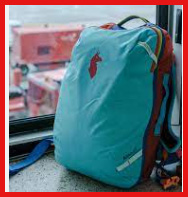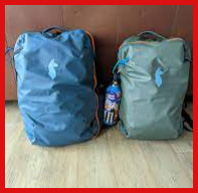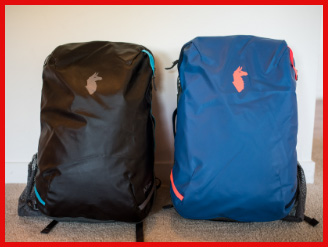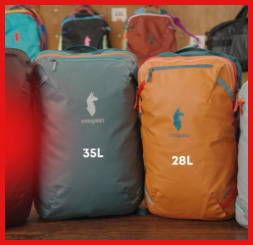I’m a frequent traveler, always chasing the next adventure with just a backpack in tow. Over the years, I’ve learned that the right bag can make or break a trip. That’s why I’m excited to share my experience comparing the Cotopaxi Allpa 28L and 35L travel packs. My goal is to help you decide which of these vibrant, functional bags suits your travel style. Through my own journeys, I’ll break down their features, weigh the pros and cons, and offer practical insights to guide your choice.
A Brief Comparison Table
| Feature | Allpa 28L | Allpa 35L |
| Capacity | 28 liters | 35 liters |
| Dimensions | 19” x 12” x 9” (48 x 30 x 23 cm) | 20” x 12” x 10” (51 x 30 x 25 cm) |
| Weight | 3.3 lbs (1.5 kg) | 3.7 lbs (1.7 kg) |
| Carry-On Compliance | Yes, fits most airline carry-on | Yes, fits most airline carry-on |
| Personal Item Fit | Fits under most airplane seats | Unlikely to fit under seats |
| Laptop Sleeve | Up to 15” | Up to 15” |
| Water Bottle Pocket | Yes (external, stretch) | Yes (external, stretch) |
| Hip Belt | Simplified, stowable | Padded, removable |
| Price | ~$170 | ~$200 |
| Best For | Weekend trips, light packers | Longer trips, heavier packers |
My Journey With The Cotopaxi Allpa Packs
Read More: My Thought onTimbuk2 Vs. Tumi

I’ve lugged both the Allpa 28L and 35L across cities, airports, and trails, from a quick weekend in Copenhagen to a two-week trek through Southeast Asia. Each bag has its charm, but they cater to different needs. Let me walk you through my experience, sharing what I loved, what frustrated me, and how these packs performed in real-world travel scenarios. Whether you’re a minimalist or someone who packs “just in case,” I’ll help you figure out which Allpa is your travel soulmate.
Design And Build Quality
Both Allpa packs share Cotopaxi’s signature vibrant aesthetic and rugged construction. The TPU-coated 1000D polyester and 840D ballistic nylon paneling feel like they could survive a tumble down a cobblestone street—and they have. I’ve dragged my 28L through crowded markets in Bangkok without a scratch, and the 35L held up during a rainy bus ride in Portugal. The chunky YKK zippers are a standout, with anti-theft webbing that makes it tough for pickpockets to sneak in. I once caught a curious hand near my bag in a busy train station, but the zipper loops kept my gear safe.
The Del Día versions, made from repurposed fabrics, add a unique, eco-friendly flair. My 28L in Desert is a neutral tan, while my 35L Del Día is a wild mix of blues and reds—no two are alike. The downside? The Del Día’s TPU coating might not be as water-resistant as standard models, so I always pack the included rain cover for wet climates.
Both bags open clamshell-style, like a suitcase, which I find genius for organization. I can lay them flat on a hostel bed and see everything at a glance. However, the 35L’s extra access pocket and deeper internal compartments give it a slight edge for those who love compartmentalizing. The 28L, while still organized, feels a tad more compact, sometimes forcing me to prioritize what goes where.
Capacity And Packing Experience

The 28L and 35L differ most in their capacity, and this is where your travel style comes into play. I’m a light packer by nature, so the 28L often feels like the Goldilocks of bags—just right. On a four-day trip to Denmark, I packed three outfits, toiletries, a 13-inch MacBook, and snacks, with room to spare. It fit perfectly under the seat on a Ryanair flight, even when stuffed, which saved me from gate-checking stress.
The 35L, however, is my go-to for longer trips or colder destinations requiring bulkier gear. During a two-week trip to France, I packed sweaters, a rain jacket, and camera gear, including my Fuji XT-5 with a 16-80mm lens. The extra space was a lifesaver, but it came at a cost—it’s too big to fit under most airplane seats, meaning it often ends up in the overhead bin. If you’re a one-bag traveler aiming to avoid checked luggage, the 35L’s size pushes the carry-on limit for strict airlines like Spirit or Ryanair.
Packing both bags feels like solving a puzzle. The 28L’s right side is shallower due to the laptop sleeve, which can make weight distribution uneven if you overpack one side. I learned this the hard way when my bag tipped over in a café because I’d stuffed too many books on the left. The 35L’s deeper compartments balance better, but overpacking can make it feel like you’re carrying a small boulder. My tip? Use packing cubes to keep things tidy—both bags have mesh compartments, but cubes make unpacking a breeze.
Comfort And Carry
Comfort is where these bags diverge significantly, especially for different body types. I’m 5’3” with a short torso, so the 28L fits me like a glove. The simplified hip belt and contoured shoulder straps distribute weight evenly, and I can walk for hours without feeling like a pack mule. On a day hike in Colorado, the 28L carried my water, snacks, and a jacket without digging into my shoulders. The stowable straps are a godsend for airport security—no snags on conveyor belts.
The 35L, however, is a mixed bag. Its padded hip belt and thicker shoulder straps are designed for heavier loads, but they’re less comfortable for smaller frames. During a long walk in Lisbon, the hip belt sat too high on my waist, making it useless for weight distribution. My 6’4” friend, however, swears by the 35L, saying it’s the only bag that doesn’t make his back ache on long trips. If you’re taller or have a longer torso, the 35L’s harness system might suit you better.
Both bags lack load-lifter straps, which I found frustrating when carrying heavier loads. The 35L’s weight (3.7 lbs empty) also feels noticeable compared to the 28L (3.3 lbs). For hot climates, the lack of airflow in the back panel is a drawback—my back was sweaty after a day in Thailand with either bag. If you’re planning long carries in warm weather, pack light or expect some discomfort.
Organization And Accessibility
The Allpa’s internal organization is a Type A traveler’s dream. Both sizes feature mesh compartments, a padded laptop sleeve, and a top pocket for quick-grab items like passports or AirPods. The 28L’s layout is slightly more compact, with two mesh compartments on the left and one on the right. I fit my toiletries, cables, and a journal easily, but the shallow right side limits bulkier items. The 35L adds an extra internal pocket for valuables and deeper compartments, which I used to separate camera gear from clothes on a trip to Italy.
The external stretch water bottle pocket, added in recent redesigns, is a game-changer for both bags. My 24-ounce Nalgene fits snugly in the 28L, but wider bottles like a 32-ounce Hydro Flask can slip out if the bag tips over. The 35L’s pocket is identical, so no advantage there. The top pocket on both is roomy enough for a power bank and sunglasses, but the 35L’s front admin panel adds extra organization for small items like pens or a travel wallet.
One quirk? The 35L’s laptop compartment opens sideways, which means your device might slide out if you open it upright. I nearly dropped my MacBook in a crowded airport before I learned to lay the bag flat first. The 28L’s laptop sleeve is more secure, with a top-opening design that keeps things in place.
Durability And Sustainability
Cotopaxi’s commitment to sustainability is a big draw for me. Both bags use recycled fabrics in newer models, and the Del Día versions repurpose excess materials, reducing waste. I love that my 35L Del Día is one-of-a-kind, but I’ve noticed the TPU coating feels slightly less robust than the standard 28L’s. After three years of use, my 28L shows no signs of wear, while the 35L has minor scuffs from being tossed into overhead bins.

The zippers and fabric are built to last, but the 35L’s heavier weight makes it feel more like a tank. I’ve never needed the rain cover for quick dashes through drizzle, as both bags are water-resistant enough for light rain. For torrential downpours, though, the cover is a must, especially for the Del Día models.
Travel Scenarios: When To Choose Each
Let’s talk real-world use. The 28L is my pick for weekend trips or minimalist travel. I took it to Hawaii for six days, packing light with just a few outfits and my camera with a pancake lens. It slid under the seat on United Airlines, even slightly overpacked, and I had no issues at security. It’s also great as a personal item alongside checked luggage, fitting books, snacks, and a change of clothes.
The 35L shines for longer trips or when you need more gear. On a two-month trip through Spain and Portugal, I packed for varied weather—sweaters, a rain jacket, and boots—and still had room for souvenirs like a small jar of local honey. It’s carry-on compliant for most airlines, but don’t expect it to fit under the seat. If you’re a one-bag traveler for week-long trips or love having extra space, the 35L is your match.
Pros And Cons Of The Cotopaxi Allpa 28L
Pros
- Compact Size: Perfect for weekend trips or as a personal item under airplane seats.
- Lightweight: At 3.3 lbs, it’s easier to carry for smaller frames or long walks.
- Carry-On Compliance: Meets TSA and most airline carry-on standards.
- Organization: Mesh compartments and a top pocket keep essentials tidy.
- Durability: TPU-coated fabric and YKK zippers withstand rough handling.
- Sustainability: Recycled fabrics and Del Día options reduce environmental impact.
Cons
- Limited Capacity: Fills up quickly for trips longer than a few days.
- Shallow Right Side: Laptop sleeve reduces space, causing uneven weight distribution.
- No Load-Lifters: Heavy loads can strain shoulders over long periods.
- Minimal External Storage: Only one external pocket limits quick-access options.
Pros And Cons Of The Cotopaxi Allpa 35L
Pros
- Spacious: Ideal for week-long trips or bulkier gear.
- Enhanced Organization: Extra internal pocket and deeper compartments for gear separation.
- Comfort for Larger Frames: Padded hip belt and straps suit taller travelers.
- Carry-On Compliance: Fits most airline overhead bins.
- Robust Build: Heavy-duty materials handle rough travel conditions.
- Water Bottle Pocket: External stretch pocket fits most standard bottles.
Cons
- Too Big for Under-Seat: Doesn’t fit as a personal item on most flights.
- Heavier: At 3.7 lbs, it feels bulky when fully packed.
- Hip Belt Fit: Uncomfortable for smaller frames, sits too high.
- Side-Opening Laptop Sleeve: Risk of device slipping out if not careful.
My Personal Takeaways

After using both bags extensively, I lean toward the 28L for its versatility and ease of use. It’s my go-to for quick getaways or when I want to travel light without sacrificing organization. The 35L, while fantastic for longer trips, feels like overkill for my 5’3” frame, especially when I’m navigating crowded airports or city streets. That said, if you’re taller or need more space for gear-heavy trips, the 35L’s extra capacity and comfort features might tip the scales.
One thing I appreciate about both is Cotopaxi’s ethos. Their focus on sustainability and vibrant designs makes me feel good about my purchase, beyond just functionality. But if I had to pick one, the 28L’s compact size and under-seat compatibility win for my minimalist travel style. Your choice depends on how much you pack and where you’re headed—think about your typical trips and body type before deciding.
Frequently Asked Questions
Yes, the Allpa 28L is comfortable for smaller frames or light loads, with contoured straps and a stowable hip belt. It’s less ideal for heavy loads due to no load-lifter straps.
No, the 35L is too large to fit under most airplane seats. It’s better suited as a carry-on for overhead bins.
Yes, the 28L meets TSA and most airline carry-on standards, typically fitting within 22” x 14” x 9” limits.
Yes, the 28L fits under most airplane seats, even when packed full, making it a great personal item.
Conclusion: Which Allpa Is Right For You?
Read More: My Thought onTimbuk2 Vs. Tumi
Choosing between the Cotopaxi Allpa 28L and 35L comes down to your travel needs and body type. If you’re like me—a light packer who loves quick trips or values under-seat convenience—the 28L is your perfect companion. It’s compact, organized, and comfortable for smaller frames. But if you need space for longer adventures or have a taller build, the 35L’s extra capacity and padded harness will serve you well. Both bags reflect Cotopaxi’s durable, sustainable ethos, so you can’t go wrong. Pick the one that fits your journey, and hit the road with confidence.
